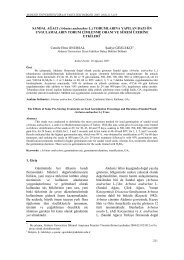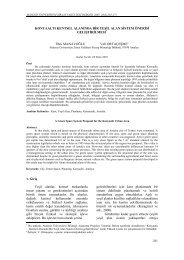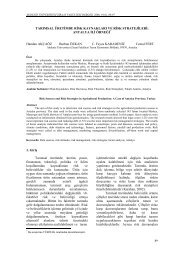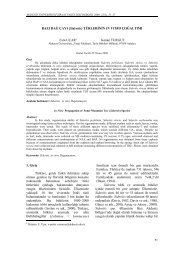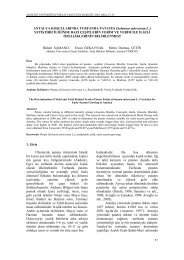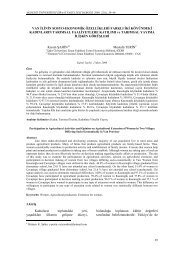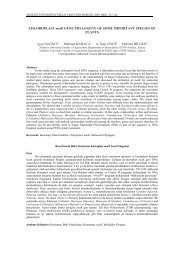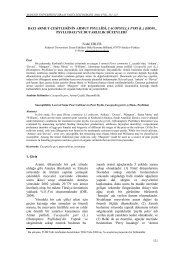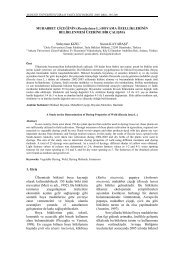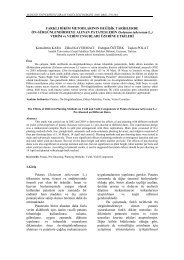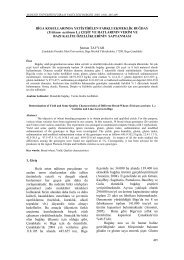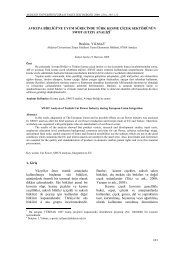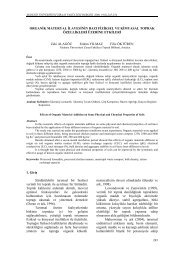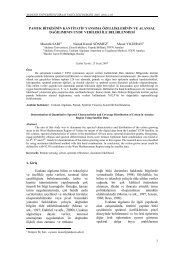INVESTIGATION OF MALE STERILITY IN SUGARBEET ...
INVESTIGATION OF MALE STERILITY IN SUGARBEET ...
INVESTIGATION OF MALE STERILITY IN SUGARBEET ...
You also want an ePaper? Increase the reach of your titles
YUMPU automatically turns print PDFs into web optimized ePapers that Google loves.
AKDENİZ ÜNİVERSİTESİ ZİRAAT FAKÜLTESİ DERGİSİ, 2005, 18(2), 295-300<br />
<strong><strong>IN</strong>VESTIGATION</strong> <strong>OF</strong> <strong>MALE</strong> <strong>STERILITY</strong> <strong>IN</strong> <strong>SUGARBEET</strong> POPULATIONS<br />
Hüseyin KOÇ<br />
Department of Field Crop Faculty of Agriculture Gaziosmanpasa University, Tokat, Turkey<br />
Correspondence addressed E-mail: hkoc@gop.edu.tr<br />
Abstract<br />
The main aim of this research was to select male sterile parents for breed triploid monogerm sugarbeet (Beta<br />
vulgaris subspp saccarifera) cultivars. Monogerm triploid hybrid sugarbeet cultivars that obtained using cytoplasmic male<br />
sterility have been grown over large areas throughout the world. Identification of male sterile plant is easy; however, Otype<br />
plants need progeny test for identification. The experiment was conducted in the fields of seed production of Sugar<br />
Institute in Adapazarı and Ankara during 1984-1996. Diploid and tetraploid plants were selected by using chromosome<br />
counts from 21 anisoploid populations. During the flowering season, 231.424 plants were examined for fertility, and 190<br />
plants were identified as male sterile. The seeds obtained from these plants were used to grow seedlings which were<br />
bolted and checked for the extent of sterility after vernalization. Male sterile progeny ratios of these plants varied between<br />
3.17 % and 18.84 % from population to population. A possitive and strong correlation was found between male sterile<br />
plant ratio and O-Type plant ratio within the same population. Based on this correlation, numbers of progeny test were<br />
calculated as between 24-148 for the populations.<br />
Keywords: Male Sterility, Vernalization, Progeny Test<br />
Şeker Pancarı Populasyonlarında Erkısırlık Araştırması<br />
Özet<br />
Araştırmanın amacı, monogerm triploid hibrit şeker pancarı çeşidi ıslah etmek için erkısır ebeveynleri seçmektir.<br />
Erkısırlıktan yararlanılarak elde edilen monogerm triploid hibrit şeker pancarı çeşitleri (Beta vulgaris subspp saccarifera),<br />
dünyada geniş alanlarda ekilmektedir. Populasyonda, erkısır bitkilerin morfolojik olarak ayırt edilmesi oldukça kolay<br />
olduğu halde, O-Tip bitkilerin belirlenmesi için döl testi melezi yapmak gerekir. Araştırma, 1984-1996 yılları arasında,<br />
Şeker Enstitüsü’nün Ankara ve Adapazarı’ndaki tohum üretim tarlalarında yapılmıştır. 21 adet anisoploid populasyondan,<br />
kromozom sayımı ile, diploid ve tetraploid bitkiler seçilmiştir. Çiçeklenme döneminde, populasyonlara ait toplam 231.424<br />
bitki, erkısırlık bakımından kontrol edilerek toplam 190 adet erkısır bitki tespit edilmiştir. Bu bitkilerden alınan tohumlar<br />
ekilmiş ve yetiştirilen fideler vernelizasyona tabi tutulduktan sonra sapa kaldırılmıştır. Bu bitkilerin dölleri arasında<br />
erkısırlık oranları belirlenmiştir. Erkısır bitki oranlarının populasyonlara göre % 3.17-18.84 arasında değiştiği<br />
saptanmıştır. Aynı populasyondaki erkısırlık oranı ile O-Tip bitki oranı arasındaki korelasyonlara bağlı olarak yapılan<br />
hesaplamalarla, populasyonlarda döl testine tabi tutulması gereken bitki sayılarının 24-148 arasında değiştiği bulunmuştur.<br />
Anahtar Kelimeler: Erkısırlık, Vernelizasyon, Döl Testi<br />
1. Introduction<br />
Commercial triploid seed production is<br />
only achieved by use of cytoplasmic male<br />
sterility (CMS) in F1 progenies (Owen, 1946;<br />
Schoroter, 1967; Kleon, 1967; Koç, 1989a).<br />
For this production, one of the parents must be<br />
monogerm (2n or 4n) CMS (Sxxzz) (Owen,<br />
1948, 1950; Hagihara et al., 1999), the other<br />
one must be O-Type (Maintainer has<br />
alternative ploidy of CMS) (Nxxzz) (Koç,<br />
1988c; Panella and Hecker, 1995; Orlov,<br />
2000). It is very easy to identify CMS parent<br />
based on morphological traits in the<br />
populations during the flowerin period. But<br />
the O-type plants could be identified by only<br />
progeny test method (Owen, 1948; Margara,<br />
1954; Cleij, 1967; Schoroter, 1967;<br />
Hogaboam, 1967; Zinecker, 1975; Gerald and<br />
Stewart, 1977; Koç, 1983, 1989a, 2001).<br />
There is a strong and positive correlation<br />
between the frequency of male sterile and O-<br />
Type plant ratios within a population<br />
(Schoroter, 1967; Koc, 1989a). In order to<br />
exploit this relationship, first of all, the male<br />
sterile plants are identified and selected and
Investigation of Male Sterility in Sugarbeet Populations<br />
the ratios of male sterility are calculated<br />
(Savitsky, 1952; Koç, 1988b). Consequently,<br />
the breeders have to find at least two O-Type<br />
plants in each population (Koç and Kandemir,<br />
1992; Koç, 1983, 1988b, 1989a and 2001).<br />
Numbers of the progeny test can be calculated<br />
using the ratio of male sterile plant in the same<br />
population (Tatlıoglu, 1978; Koç, 1989a). The<br />
main aim of this experiment was to select<br />
male sterile parents for breed triploid<br />
monogerm sugarbeet cultivar (Beta vulgaris<br />
subspp saccarifera).<br />
2. Material and Method<br />
Twenty one ansoploid populations were<br />
used in this study. They were collected from<br />
various countries to improve new cultivar(s)<br />
during 1984-1986. The development of new<br />
triploid hybrid cultivar(s) was planned to use<br />
these lines in the following years. For this<br />
purpose, O-Type and male sterile plants were<br />
identified in each population (Koç, 1989c).<br />
During course of elite seed production,<br />
each plant was periodically controlled for<br />
sterility throughout the flowering season.<br />
After identifiying male sterile plants, they<br />
were open pollinated to produce F1 hybrid<br />
seeds (Koç, 1989b). The seeds were sown in<br />
the boxes and later germinated seedlings were<br />
transferred to the pots (Koç, 1989d).<br />
The seedlings were transferred to the<br />
environmental chamber at the 6-8 leaf stage<br />
with maintenance of temperature at 4-8 ˚C<br />
during 10 weeks for vernalization. Thereafter,<br />
the seedlings were transferred to controlled<br />
conditions of 19+1 ˚C and 18 h/day light to<br />
stimulate growth (Cucrth, 1967; Koç, 1983<br />
and 1989d; Guan et al., 1994; Koç, et al.,<br />
1995). Bolted plants were examined for male<br />
sterility 3 times, every 10 days. Fertility status<br />
of each genotype in F1 progeny was identified<br />
by accounting for their ratios (Tatlıoglu, 1978;<br />
Koç, 1983, 1988a and 1989a). Atleast two O-<br />
Type plants had to be found in a population<br />
for maintaining of O-Types. For this purpose,<br />
fertility-sterility status of F1 progenies were<br />
296<br />
used, and calculated with Binomial Dispersion<br />
(Tatlıoglu, 1978; Koç, 1989a).<br />
3. Results and Discussions<br />
The male sterile plants were determined<br />
during the flowering period in the elite<br />
parcels. Total number of examined plants,<br />
identified male sterile plants, their status for<br />
fertility or sterility, and ratios in F1 progenies<br />
were given in Table 1. Out of 231.424 plants<br />
examined during experimental years in the<br />
original population, 190 of them were male<br />
sterile. Number of the male sterile plants (1-19<br />
pieces for populations) and their ratios (0.010-<br />
0.143 %) were low. Only one male sterile<br />
plant was found in each of the KMP and R<br />
populations. Low ratio of male sterility was<br />
reported by Owen (1945) as 6 % and 0.1 %,<br />
by Bandlow (1964) as 0.1-1.0 %, by Kleon<br />
(1967) as 0.15 % and by Lecochec (1969) as<br />
1.0 %. Koç (1989a) found no male sterile<br />
plants in his two breeding lines, and 0.01-1.0<br />
% male sterility in other breeding lines. These<br />
results supported that low number of male<br />
sterile plants found in sugarbeet populations of<br />
this study.<br />
Male sterility in the CMS plants (Sxxzz)<br />
is determined by 2 chromosomal genes and<br />
sterility factors of cytoplasm (Owen, 1948;<br />
Hagihara et al., 1999). Plant with the S<br />
cytoplasma is completely male sterile,<br />
provided its chromosomal genes are<br />
homozygous recessive (Sxxzz). If one of these<br />
two genes are dominant (X.zz or xxZ.), then<br />
this plant is semi-male sterile Type-I, and if<br />
both genes are dominant (XxZz) then it is<br />
semi-male sterile Type-II. Each of male sterile<br />
and fertile plants produces 4 different gamets<br />
with these genes combinations (xz, Xz, xZ and<br />
XZ) (Tatlıoglu, 1978; Koç, 1989a). Expected<br />
genotypic ratio in F1 progeny after open<br />
pollination (AJ-3 population) was given in<br />
Table 2. Table 2 shows alternative gamet<br />
combinations with occurance of 16 different<br />
genotypes (Tatlıoglu, 1978; Koç, 1989a)<br />
which are given in Table 3.
H. KOÇ<br />
Table 1. Genotypic dispersions of male sterile plants in F1 progenies<br />
Cultivars<br />
Male sterile<br />
plants<br />
Frequency of the sterility and fertility in the F1 progenies Observed<br />
Observed<br />
plants Numbers % (xxzz)(a) (Xxzz) (xxZz) (XXZZ)<br />
Numbers % Numbers % Numbers % Numbers %<br />
F1<br />
progenies<br />
AJ-3 7916 6 0.076 87 39.19 46 20.72 53 23.87 36 16.22 222<br />
KWE 13283 19 0.143 190 25.88 251 34.20 192 26.16 101 13.76 734<br />
Max 9447 11 0.116 143 34.71 87 21.12 143 34.71 39 9.46 412<br />
PR 8654 9 0.104 126 33.87 109 29.30 82 22.04 55 14.79 372<br />
Px 16719 12 0.072 103 24.47 73 17.34 128 30.40 117 27.79 421<br />
PK 12196 17 0.139 224 26.63 251 29.85 196 23.31 170 20.21 841<br />
PO 14266 4 0.028 - - 143 68.75 65 31.25 208<br />
P-3 10095 7 0.069 83 17.77 165 35.33 128 27.41 91 19.49 467<br />
KWP 12453 16 0.128 115 18.34 243 38.76 160 25.52 109 17.38 627<br />
KMP 9814 1 0.010 - - 14 42.42 19 57.58 33<br />
KW-231 11346 4 0.035 89 43.42 16 7.80 76 37.07 24 11.71 205<br />
KW-S 10459 8 0.076 137 37.13 114 30.89 73 19.78 45 12.20 369<br />
RP 12538 13 0.104 104 35.86 99 34.14 64 22.07 23 7.93 290<br />
MP 10187 5 0.049 126 31.50 117 29.25 75 18.75 82 20.50 400<br />
MMP 8798 2 0.023 - - 29 61.70 18 38.30 47<br />
ZP 14631 18 0.123 76 40.64 54 28.88 41 21.93 16 8.56 187<br />
R 7493 1 0.013 - - 9 56.25 7 43.75 16<br />
SR 10549 5 0.047 114 32.20 103 29.10 81 22.88 56 15.82 354<br />
H-5117 9157 10 0.109 65 38.24 42 24.70 45 26.47 18 10.59 170<br />
BM 11286 15 0.133 51 33.12 37 24.03 42 27.27 24 15.58 154<br />
Tri 10137 7 0.064 19 18.81 52 51.49 21 20.79 9 8.91 101<br />
Total 231424 190 - - - - 6630<br />
Table 2. Probable genotypes and frequencies of the male sterile plants in AJ-3 cultivar<br />
xz (0.3919) Xz (0.2072) xZ (0.2387) XZ (0.1622)<br />
xz (0.3919) xxzz (a)(0.1536) Xxzz (0.8120) xxZz (0.9355) XxZz (0.6357)<br />
Xz (0.2072) Xxzz (0.8120) XXzz (0.4293) XxZz (0.4946) XXZz (0.3361)<br />
xZ (0.2387) xxZz (0.9355) XxZz (0.4946) xxZZ (0.5698) XxZZ (0.3872)<br />
XZ (0.1622) XxZz (0.6357) XXZz (0.3361) XxZZ (0.3872) XXZZ (80.2631)<br />
Table 3. Observed numbers of genotypes and phenotypes at the end of the open pollination<br />
Genotypes Phenotypes Numbers<br />
Xxzz Completely male sterile 1<br />
Xxzz Semi-male sterile Type-I 2<br />
XXzz Semi-male sterile Type-I 1<br />
xxZz Semi-male sterile Type-I 2<br />
xxZZ Semi-male sterile Type-I 1<br />
XxZz Semi-male sterile Type-II 4<br />
XXZz Semi-male sterile Type-II 2<br />
XxZZ Semi-male sterile Type-II 2<br />
XXZZ Fertile 1<br />
Total 16<br />
One of the 16 genotypes had<br />
homozygous recessive (xxzz) chromosomal<br />
gene combination, six of them had one<br />
dominant gene (Xxzz or xxZz: Semi-male<br />
sterile Type-I), 8 of them had two<br />
heterozygous dominant genes (XxZz: semimale<br />
sterile Type-II) and one of them had<br />
homozygous dominant (XXZZ: fertile) genes.<br />
Ratios of genotypes were determined and were<br />
given in Table 4 showing that among F1<br />
progenies of male sterile plants belonging to<br />
PO, KMP, MMP and R populations, male<br />
sterile progeny was not found. The ratios of<br />
the other populations varied between 3.17 %<br />
297
Investigation of Male Sterility in Sugarbeet Populations<br />
Table 4. Genotypic dispersions of male-sterile parents (%) from F1 progenies<br />
Cultivars xxzz (a) Xxzz XXZz xxZz xxZZ XxZz XXzz XxZZ XXZZ<br />
AJ-3 15.37 16.21 6.70 18.74 5.70 22.60 4.88 7.74 2.67<br />
KWE 6.70 17.72 9.42 13.57 6.83 25.06 11.68 7.20 1.90<br />
Max 12.04 14.64 4.00 24.08 12.04 21.24 4.45 6.60 0.91<br />
PR 11.48 19.86 8.68 14.92 4.84 22.93 8.59 6.52 2.18<br />
Px 6.00 8.48 9.62 14.90 9.24 24.14 2.99 16.90 7.73<br />
PK 7.09 15.90 12.07 12.42 5.43 24.68 8.91 9.42 4.08<br />
PO - - - - 47.6 - - 42.78 9.62<br />
P-3 3.17 12.56 13.76 9.76 7.52 26.28 12.46 10.68 3.81<br />
KWP 3.35 14.20 13.50 9.34 6.50 26.14 15.05 8.88 3.04<br />
KMP - - - - 17.98 - - 48.84 33.18<br />
KW-231 18.84 6.78 1.82 32.20 13.76 15.94 0.61 8.68 1.37<br />
KW-S 13.74 22.92 7.54 14.70 3.92 21.30 9.55 4.84 1.49<br />
RP 12.80 24.48 5.38 15.86 4.88 20.80 11.63 3.50 0.60<br />
MP 9.92 18.46 12.02 11.72 3.46 23.82 8.58 7.63 4.21<br />
MMP - - - - 38.07 - - 47.26 14.67<br />
ZP 16.48 23.46 4.98 17.78 4.80 19.64 8.36 3.76 0.74<br />
R - - - - 31.70 - - 49.20 19.10<br />
SR 10.37 18.74 9.20 14.74 5.24 23.51 8.47 7.04 2.51<br />
H-5117 14.59 18.88 5.24 20.24 7.02 21.19 6.10 5.62 1.12<br />
BM 10.96 15.88 7.48 18.08 7.46 23.42 5.76 8.52 2.44<br />
Tri 3.54 19.37 9.16 7.82 4.33 24.76 26.53 3.70 0.79<br />
Table 5. Numbers of the required progeny test for cultivars<br />
Cultivars (a) Degries Progeny test Cultivars (a) Degries Progeny test<br />
AJ-3 0.1537 30 KW-S 0.1374 33<br />
KWE 0.067 69 RP 0.128 36<br />
Max 0.1204 38 MP 0.0992 46<br />
PR 0.1148 40 MMP - -<br />
Px 0.06 78 ZP 0.1648 27<br />
PK 0.0709 66 R - -<br />
PO - - SR 0.1037 44<br />
P-3 0.0317 148 H-5117 0.1459 31<br />
KWP 0.0335 140 BM 0.1096 42<br />
KMP - - Tri 0.354 133<br />
KW-231 0.1884 24 - - -<br />
(P-3) and 18.84 % (KW-231). Tatlıoglu<br />
(1978) and Koc (1989a) did not find any male<br />
sterile generations in their some studied<br />
populations. However, Koç (1989a) found<br />
ratios of the male sterile plants between 24.4<br />
% and 54.6 % in his some other populations.<br />
If the ratio of male sterility is high among F1<br />
progenies, the number of required progeny test<br />
is low for this population. If the male sterility<br />
ratio is low among F1 progenies, number of<br />
the convenient progeny test is high (Schoroter,<br />
1967; Koç, 1989a). To find two or more O-<br />
Type plants in a given population number of<br />
required progeny test could be found, using<br />
formula (a + b) n = 1 bionomial dispersion<br />
298<br />
(Tatlıoglu, 1978; Koç, 1989a). At this<br />
binomial dispersion: to be able to find two or<br />
more O-Type plants in a given population<br />
number of required progeny test could be<br />
found, using formula (a + b) n = 1 bionomial<br />
dispersion (Tatlıoglu, 1978; Koç, 1989a). At<br />
this binomial dispersion:<br />
a. Frequency of male sterile progeny<br />
among the F1 progenies of male sterile parents.<br />
b. Frequency of O-Type plants in the<br />
same population.<br />
n. The number of the required progeny<br />
tests.<br />
To be able to find atleast two O-Type<br />
plants, within 95 % probability level, n
number of the binomial dispersion is<br />
accounted following as:<br />
For AJ-3 population:<br />
a + b = 1<br />
a = 0.1537 (from Table 4)<br />
b = 0.8643 (1-0.1537)<br />
(a + b) n = b n + nb n-1 a n(n-1)b n-2 a 2 +.. +<br />
nba n-1 + a n<br />
95 % 5 %<br />
(Probability being O-Type) or<br />
0.05 ≥ (1 – 0.1537) n + n(1-0.1537) n-1 (0.1537)<br />
This n number is 30 for AJ-3<br />
population. With the same principles, the<br />
numbers could be accounted for each<br />
population. Accounted numbers are given in<br />
Table 5, which is required progeny tests, these<br />
numbers varied from population to population.<br />
References<br />
Banlow, G. 1964. Die genetic der Beta vulgaris-<br />
Rüben. Zuchter, 25: 104-122.<br />
Cleij, G. 1967. Influencing of the cytoplasmic male<br />
sterility and fertility in beets. Euphytica, 16:<br />
123-128.<br />
Curth, P. 1967. Blühindüktion bei<br />
zückerrübensteckligen durch intermittiert<br />
gebontenes mütternachtlinches störlicht.<br />
Zuhter, 37: 119-120.<br />
Gerald, M. C. and Stewart, D. 1977. Cytoplasmic<br />
male sterility, self-fertility and<br />
monogermness in Beta maritima L. Amer.<br />
Soc. Sugar Beet Techn., 19: 257-261.<br />
Guan, G., Abe, D and Shimamoto, Y. 1994.<br />
Genetic analysis of bolting tendency in<br />
sugarbeet. Proc. Jap. Soc. Sugar Beet<br />
Technologists, 36: 145-151.<br />
Hagihara, E., Itchoda, N., Kuba, T., Habu, Y., Lida<br />
S. and Mikami, T. 1999. AFLP and RAPD<br />
markers tightly linked to fertility restorer<br />
genes for the Owen cytoplasmic male<br />
sterility in sugarbeet. Proc. Jap. Soc. Sugar<br />
Beet Techn., 41: 73-77.<br />
Hogaboam, G. 1967. Factors influencing<br />
phenotype expression of cytoplasmic male<br />
sterility in the sugar beets. J. Amer. Soc.<br />
Sugar Beet Technologists, 9: 457-465.<br />
Kleon, D. 1967. Die ausnutzung der heterosis bei<br />
di-und tetraploiden rüben. Aus. Tag. Ber. dt.<br />
Akad. Landwirtsch. W. Berlin, 89: 275-294.<br />
H. KOÇ<br />
Moreover, required progeny test numbers<br />
were low in the populations which have high<br />
ratio of male sterile plant, and were high in<br />
thepopulations having low ratio of male sterile<br />
plant. The lowest number of the progeny test<br />
(with 24 pieces) was found in P3 population.<br />
Koç (1988a and 1989a) investigated O-Type<br />
plants in 18 breeding lines and varietied<br />
progeny test number from 14 to 76. In the<br />
following years, O-Type plants were<br />
investigated in these populations by the author<br />
and were reported in his anothers manustcript.<br />
Acknowledgements<br />
The author wishes to thank Assoc. Prof. Dr.<br />
Sabit ERŞAHİN for his valuable critisms on this<br />
manuscript.<br />
Koç, H. 1983. Selection O-Type parent in<br />
sugarbeet for male sterile breeding. Ph. D.<br />
Thesis, Ankara Üni. Fen Bilimleri<br />
Enstitüsü.<br />
Koç, H. 1988a. Investigation on the obtaining O-<br />
Type plant in the sugarbeet populations. T.<br />
J. Agric. For. 12: 144-153.<br />
Koç, H. 1988b. Using methods from self-fertile<br />
sugarbeet populations for O-Type<br />
investigations. T. J. Agric. For., 12: 154-<br />
158.<br />
Koç, H. 1988c.The vegetative keeping techniques<br />
of the clones for O-Type investigations. T.<br />
J. Agric. For., 12: 158-162.<br />
Koç, H. 1989a. Investigation of male sterile plants<br />
in Turkseker-I’s breeding lines. T. J. Agric.<br />
For., 13: 607-615.<br />
Koç, H. 1989b. Improvement new inbred lines in<br />
different anisoploid populations. T. J. Agric.<br />
For., 13: 623-630.<br />
Koç, H. 1989c. Investigations on identified O-Type<br />
plant in different breeding lines. T. J. Agric.<br />
For., 13: 616-623.<br />
Koç, H. 1992. Investigation on the methods of the<br />
bolting to sugarbeet in a year. Hasad 47: 26-<br />
29.<br />
Koc, H. and Kandemir, N. 1992. Investigation of<br />
O-Type plant using plant tissue culture<br />
technique. XI. National Biology Congress,<br />
24-27 July, Elazig, Turkey, s, 181-188.<br />
299
Investigation of Male Sterility in Sugarbeet Populations<br />
Koc, H., Kasap, A., Akdag, C., Gökmen S. and<br />
Akman, Z. 1995. Determination of the O-<br />
Type plants from self-fertil and self-sterile<br />
monogerm sugarbeet populations.<br />
Gaziosmanpasa Uni. J. Agriculture., 12:<br />
172-181.<br />
Koc, H. 2001. Use of in vitro propagation for CMS<br />
maintainer line screening in sugar beet<br />
population. USAMV-CN, p, 297-302.<br />
Lecochec, F. 1969. Les possibilities d’amelioration<br />
de la betterave fourragere (Beta vulgaris L.)<br />
Ann. Amelior. Plantes. 19: 169-211.<br />
Margara, J. 1954. Les problemes annexes la<br />
selection de betterave. Ann. L’Amelior.<br />
Plants. 2: 179-184.<br />
Orlov, S. D. 2000. Improvement of the O-Type<br />
lines and their inter-cultivar analogues.<br />
Sakharnaya Svekla, 12: 14-15.<br />
Owen, F. V. 1945. Cytoplasmic inherited male<br />
sterility in sugar beet. J. Amer. Agr. Res.,<br />
71: 423-439.<br />
Owen, F. V., Murphy, A. M. and Ryser, G. K.<br />
1946. Inbred lines from Curly-top resistant<br />
varieties of sugarbeet. Proc. Amer. Soc.<br />
Sugar Beet Techn., p, 246-252.<br />
300<br />
Owen, F. V. 1948. Utilization of male sterility in<br />
bereeding superior yielding sugarbeets. J.<br />
Amer. Soc. Sugar Beet Techn., p, 156-161.<br />
Owen, F. V. 1950. The sugar beet breeders<br />
problems of establishing male sterile<br />
population for hybridization purposes. Proc.<br />
Amer. Sugar Beet Techn., 6: 191-194.<br />
Panella, L. W. and Hecker, R. J. 1995. Registration<br />
of annual O-Type and CMS sugarbeet<br />
germplasm lines FC404 and FC404CMS.<br />
Crop Sci. 35: 1721.<br />
Savitsky, H. 1952. Poliploid sugar beets,<br />
cytologically study and methods of<br />
production. Proc. Amer. Soc. Sugarbeet<br />
Techn., 7: 470-476.<br />
Schoroter, W. 1966. Breeding male sterile<br />
monocarpic sugarbeets. Tag. Ber. dt. Akad.<br />
Landwirtsch. W. Berlin, 89: 303-319.<br />
Tatlıoglu, T. 1978. Investigation of male sterile<br />
plants in sugarbeet populations. Plant, 5: 1-<br />
15.<br />
Zinecker, M., Schoroter, W. and Behrens, H. O.<br />
1975. Results of work on the production of<br />
O-Type of sugarbeet. Archiv für<br />
Züchtungsforschung, 5: 123-132.



